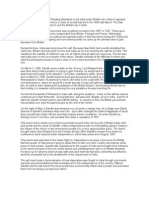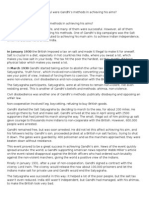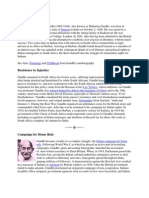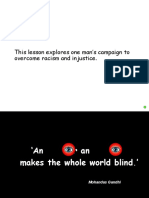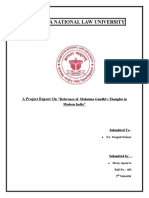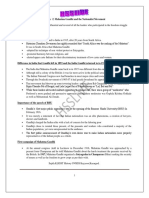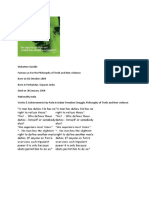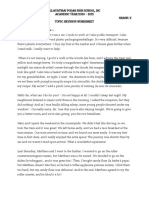0 ratings0% found this document useful (0 votes)
27 viewsGandhi Movie Synopsis
Gandhi Movie Synopsis
Uploaded by
Natasha Dalal1) Gandhi begins in 1948 showing Gandhi's assassination and funeral, then flashes back to 1893 when a young Gandhi was thrown off a train for being Indian and sparked his interest in fighting discrimination.
2) Gandhi leads numerous non-violent protests and strikes against discriminatory British laws, often getting arrested. This includes organizing a salt march in 1930 to protest British control of salt production.
3) As violence increases between Hindus and Muslims in the late 1940s over the possibility of an independent India and Pakistan, Gandhi agrees to partition but fasts in protest against the violence and sectarian clashes during the transition to independence. He is assassinated in 1948, less than a year after independence.
Copyright:
© All Rights Reserved
Available Formats
Download as PDF, TXT or read online from Scribd
Gandhi Movie Synopsis
Gandhi Movie Synopsis
Uploaded by
Natasha Dalal0 ratings0% found this document useful (0 votes)
27 views2 pages1) Gandhi begins in 1948 showing Gandhi's assassination and funeral, then flashes back to 1893 when a young Gandhi was thrown off a train for being Indian and sparked his interest in fighting discrimination.
2) Gandhi leads numerous non-violent protests and strikes against discriminatory British laws, often getting arrested. This includes organizing a salt march in 1930 to protest British control of salt production.
3) As violence increases between Hindus and Muslims in the late 1940s over the possibility of an independent India and Pakistan, Gandhi agrees to partition but fasts in protest against the violence and sectarian clashes during the transition to independence. He is assassinated in 1948, less than a year after independence.
Original Description:
nmmn
Copyright
© © All Rights Reserved
Available Formats
PDF, TXT or read online from Scribd
Share this document
Did you find this document useful?
Is this content inappropriate?
1) Gandhi begins in 1948 showing Gandhi's assassination and funeral, then flashes back to 1893 when a young Gandhi was thrown off a train for being Indian and sparked his interest in fighting discrimination.
2) Gandhi leads numerous non-violent protests and strikes against discriminatory British laws, often getting arrested. This includes organizing a salt march in 1930 to protest British control of salt production.
3) As violence increases between Hindus and Muslims in the late 1940s over the possibility of an independent India and Pakistan, Gandhi agrees to partition but fasts in protest against the violence and sectarian clashes during the transition to independence. He is assassinated in 1948, less than a year after independence.
Copyright:
© All Rights Reserved
Available Formats
Download as PDF, TXT or read online from Scribd
Download as pdf or txt
0 ratings0% found this document useful (0 votes)
27 views2 pagesGandhi Movie Synopsis
Gandhi Movie Synopsis
Uploaded by
Natasha Dalal1) Gandhi begins in 1948 showing Gandhi's assassination and funeral, then flashes back to 1893 when a young Gandhi was thrown off a train for being Indian and sparked his interest in fighting discrimination.
2) Gandhi leads numerous non-violent protests and strikes against discriminatory British laws, often getting arrested. This includes organizing a salt march in 1930 to protest British control of salt production.
3) As violence increases between Hindus and Muslims in the late 1940s over the possibility of an independent India and Pakistan, Gandhi agrees to partition but fasts in protest against the violence and sectarian clashes during the transition to independence. He is assassinated in 1948, less than a year after independence.
Copyright:
© All Rights Reserved
Available Formats
Download as PDF, TXT or read online from Scribd
Download as pdf or txt
You are on page 1of 2
Plot Summary
Gandhi begins in 1948, showing Mahatma Gandhi’s assassination and state
funeral in New Delhi, India.
The next scene goes back in time to 1893. Gandhi is a young Indian attorney
who is thrown off a train. The conductor tells him “coloured” people are not allowed
to travel first class. Gandhi is shocked to learn about the discrimination against
Indian immigrants, and he joins with an Indian businessman, Mr. Khan, to protest.
Gandhi and Khan organize a protest where they burn the passes that Indians are
required to carry everywhere. The police arrest Khan and beat Gandhi because he
continues to burn the passes one by one. Gandhi refuses to fight back with violence.
The incident is reported in British newspapers.
When Gandhi discovers that General
Smut has passed new laws that violate Indian
civil rights, Gandhi makes a speech to a
crowded audience calling for non-violent
resistance against the new laws. The entire
room rises and promises not to obey the new
laws.
Gandhi leads a strike of Indian
miners, and the British put him in prison
along with thousands of other protesters. In
order to re-open the mines, General Smut
makes an agreement with Gandhi that he will cancel the new laws and free the
protesters, but future Indian immigration will be stopped.
In 1915, Gandhi arrives in Bombay, India to a large welcoming ceremony.
Members of the Indian National Congress Party, including Nehru, Patel, and Jinnah
(who is also leader of the Muslim League), greet Gandhi. Gandhi spends a year
travelling India to understand India better. After seeing widespread poverty, Gandhi
tells the other members of Congress Party that he disapproves of their wealthy
lifestyles. He later makes a speech to say that politicians can only represent India and
challenge the British if they truly understand the lives of the many poor people in
India.
Living a simple life in his ashram, Gandhi becomes more aware of the
poverty caused by British rule. When Gandhi is arrested for encouraging non-violent
non-cooperation with British laws, riots break
out and he is granted bail. Gandhi and his
partners gather a lot of evidence against British
landholders, and the protesting farmers
eventually receive their demands.
In response to proposed laws that would
violate Indian civil rights, Gandhi organizes a
day of fast and prayer. This has the effect of a
mass general strike and brings India to a
complete halt. The British arrest Gandhi again.
They soon agree to release him because of riots, if he will make a speech calling for
non-violence.
General Dyer orders his
troops to open fire on a public, non-
violent meeting, and 1,516 Indian
men, women and children are
killed. With even stronger
determination for Indian
independence, the Congress Party
adopts Gandhi’s policy of non-
violent civil disobedience in 1920.
A British woman called Mirabehn comes to live with him and his wife Ba.
Gandhi calls for a huge crowd to burn their British-made clothing at a peaceful rally,
but the next rally takes a violent turn when the crowd kills a group of local
policemen. Gandhi decides to fast until the protesters will stop their violence, and he
successfully ends the rioting. He is then arrested once again for sedition and
sentenced to six years in prison.
In Porbandar State several years later, New York Times reporter Mr. Walker
arrives in India to follow Gandhi’s movement. Gandhi tells him of his new plan to
protest the British tax on salt manufacture. Gandhi is joined by thousands of people
as he makes a 240-mile march
to the sea, while Walker covers
the story for global media. The
march leads to widespread
manufacture of salt by Indians
without a British licence.
During a non-violent raid on
the Dharasana Salt Works,
many Indian men are badly
beaten by local police. Walker
reports the story to the global
media.
Lord Irwin invites Gandhi to attend an all-government conference in London
to discuss the possibility of Indian independence. The conference ends with no
agreement.
During World War II, Gandhi, his wife, and Nehru are arrested for speaking
out against the war. A photographer from Life magazine, Margaret Bourke-White,
visits Gandhi during his time in prison. His wife, Ba, suffers heart problems and
eventually dies. Gandhi becomes aware of high anti-Hindu feelings among Muslims,
who have been provoked by Jinnah to fear the possibility of a mostly Hindu country.
Once World War II is over, England sends Lord Mountbatten to serve as
India’s new viceroy, and he promises to guide the country to independence. Gandhi
asks Jinnah to become the country’s first prime minister to calm Muslim fears, but
Jinnah argues that an independent Pakistan should be partitioned or else there will
be civil war.
Gandhi agrees to the partition, despite his strong hopes for unity. There are
violent clashes as Muslim refugees head out of India and Indian refugees move from
Pakistan. Gandhi begins another fast in protest of the violence, and he nearly dies
when the fighting finally stops.
Less than a year after India gains independence, Gandhi is assassinated. He is
granted a State funeral, and his ashes are released into the Ganges River.
You might also like
- Class 11 English All Chapter Complete NotesDocument73 pagesClass 11 English All Chapter Complete Notesrelemic655No ratings yet
- Nationalism in IndiaDocument6 pagesNationalism in IndiaMisbah Patel100% (3)
- Gender Issues in Women As RepresentativesDocument2 pagesGender Issues in Women As RepresentativesHamza Bilal100% (2)
- Indian Independence: The Crusade of Mahatma GandhiDocument26 pagesIndian Independence: The Crusade of Mahatma GandhiBushra JahanNo ratings yet
- Mahatma Gandhi and Nonviolent ResistanceDocument4 pagesMahatma Gandhi and Nonviolent ResistanceGrapes als Priya100% (1)
- Mahatma GandhiDocument11 pagesMahatma GandhiRogely TendenciaNo ratings yet
- Ethics and Values: Done by:SAM MELVIN.M Reg. No: 19MIS1106Document28 pagesEthics and Values: Done by:SAM MELVIN.M Reg. No: 19MIS1106Delvin companyNo ratings yet
- Mohandas Gandhi (1869-1948)Document5 pagesMohandas Gandhi (1869-1948)Ias Aspirant AbhiNo ratings yet
- Gandhi: A BiographyDocument3 pagesGandhi: A BiographyraghunathanNo ratings yet
- Salt MarchDocument1 pageSalt MarchpedretticNo ratings yet
- Study Notes On: Gandhian EraDocument8 pagesStudy Notes On: Gandhian EraAbhishek VermaNo ratings yet
- Mahatma Gandhi Video InglesDocument2 pagesMahatma Gandhi Video InglesSimão DuarteNo ratings yet
- Non-Co-Operation Movement Hind SwarajDocument4 pagesNon-Co-Operation Movement Hind Swarajabhishekkumarsharma033No ratings yet
- Mahatma Gandhi - PresentationDocument11 pagesMahatma Gandhi - PresentationFreaky Alchemist100% (1)
- Gandhi EssayDocument2 pagesGandhi Essayenns100% (1)
- Sudarshan Pol Science ProjectDocument10 pagesSudarshan Pol Science ProjectDilip JaniNo ratings yet
- 7427 Topper 21 101 505 21 10267 Mahatma Gandhi and The Nationalist Movement Up201709281302 1506583969 1465Document8 pages7427 Topper 21 101 505 21 10267 Mahatma Gandhi and The Nationalist Movement Up201709281302 1506583969 1465gowrri j geethanNo ratings yet
- Early YearsDocument3 pagesEarly YearsNikunj ShahNo ratings yet
- Disobedience and Return To Old ValuesDocument4 pagesDisobedience and Return To Old ValuesGregorio ValllejoNo ratings yet
- Civil Disobedience MovementDocument4 pagesCivil Disobedience Movementakshay kharte100% (2)
- Mahatma Gandhi: Brahmacharya (Celibacy, Striving Towards God) - Gandhi Conceived of His Own Life As A Series ofDocument4 pagesMahatma Gandhi: Brahmacharya (Celibacy, Striving Towards God) - Gandhi Conceived of His Own Life As A Series ofAhab SilenceNo ratings yet
- GandhireadingcdDocument2 pagesGandhireadingcdapi-292280948No ratings yet
- Mahatma Gandhi BiographyDocument6 pagesMahatma Gandhi BiographyRajat Yadav YaduvanshiNo ratings yet
- Dandi Salt MarchDocument2 pagesDandi Salt MarchNayan KanchanNo ratings yet
- Mahatma GandhiDocument8 pagesMahatma GandhiPUIN AMEZQUITA MONICA JULIETHNo ratings yet
- Mahatma Gandhi Album: Early Years of GandhiDocument5 pagesMahatma Gandhi Album: Early Years of GandhiGarena 4889No ratings yet
- Class 12ch 13 Mahatma GandhiDocument37 pagesClass 12ch 13 Mahatma Gandhissumanrathore30No ratings yet
- This Lesson Explores One Man's Campaign To Overcome Racism and InjusticeDocument31 pagesThis Lesson Explores One Man's Campaign To Overcome Racism and InjusticeJagrit SinghNo ratings yet
- Mahatmagandhi 141110074418 Conversion Gate02Document19 pagesMahatmagandhi 141110074418 Conversion Gate02JLNo ratings yet
- INDIGODocument20 pagesINDIGOTannu GuptaNo ratings yet
- Indian Freedom FightersDocument13 pagesIndian Freedom FighterschandbashamscNo ratings yet
- Mahatma GandhiDocument2 pagesMahatma GandhiVedant PatilNo ratings yet
- Gandhi PDFDocument16 pagesGandhi PDFJayalakshimi JayaNo ratings yet
- Mahatma Gandhi and The Nationalist MovementDocument3 pagesMahatma Gandhi and The Nationalist Movementsubhabratapaul23No ratings yet
- Freedom FightersDocument20 pagesFreedom FightersrajussplNo ratings yet
- All About INDIADocument22 pagesAll About INDIAJohn Rey LanuzaNo ratings yet
- GandhiDocument69 pagesGandhiBinode SarkarNo ratings yet
- GANDHI ImprimirDocument4 pagesGANDHI ImprimirEdgarrdzcargadorNo ratings yet
- Gandhi-Timeline of LifeDocument5 pagesGandhi-Timeline of LifemariamNo ratings yet
- Mahatma GandhiDocument27 pagesMahatma GandhiPrasanna KumarNo ratings yet
- Top 10 Freedom FighterDocument27 pagesTop 10 Freedom Fightermunishmalik1No ratings yet
- Prince of Wales Riots: Background Riots Aftermath ReferencesDocument4 pagesPrince of Wales Riots: Background Riots Aftermath ReferencesC ChanNo ratings yet
- Mahatma GandhiDocument29 pagesMahatma GandhiVivekKajlaNo ratings yet
- Bio of Mahatma GandhiDocument5 pagesBio of Mahatma GandhiNipun GuptaNo ratings yet
- SaltDocument20 pagesSaltvineethshajiNo ratings yet
- The March To FreedomDocument21 pagesThe March To Freedomridhaafathima85No ratings yet
- DownloadDocument13 pagesDownloadsanyammadaan101No ratings yet
- Curatorial Statement, GandhiDocument2 pagesCuratorial Statement, Gandhisamaira.khurana011No ratings yet
- MAHATMA GANDHI - ppt1111Document27 pagesMAHATMA GANDHI - ppt1111Patricia JosephNo ratings yet
- 2613 Topper 21 101 2 21 7344 Nationalism in India Up201507222143 1437581616 9979Document5 pages2613 Topper 21 101 2 21 7344 Nationalism in India Up201507222143 1437581616 9979parthkshyp04No ratings yet
- Nationalism in IndiaDocument15 pagesNationalism in Indiaaugustqu33nNo ratings yet
- Mahatma Gandhi: - by Avaneeh MannavaDocument7 pagesMahatma Gandhi: - by Avaneeh Mannavaashoku24007No ratings yet
- Gandhiji - A True Legend 'Document4 pagesGandhiji - A True Legend 'Sathya Sai SanthanagopalanNo ratings yet
- Chanakya National Law University: A Project Report On " "Document28 pagesChanakya National Law University: A Project Report On " "Sumanyu BhardwajNo ratings yet
- GhandiDocument20 pagesGhandiNikolas ŠkrljNo ratings yet
- XII History Theme 12 Mahatma Gandhi and The Nationalist MovementDocument9 pagesXII History Theme 12 Mahatma Gandhi and The Nationalist MovementJyotismita KhataniarNo ratings yet
- Presentation 3Document42 pagesPresentation 3x4bx5ckypvNo ratings yet
- Mohandas Karamchand GandhiDocument9 pagesMohandas Karamchand GandhiAmartya TripathiNo ratings yet
- C C CC CC CC CCCC CC CCC C!"CC CC #C$ #C &C C'C (C") CC C +C, C-C.C/ CC%C c0 11#c C C CC CC CDocument9 pagesC C CC CC CC CCCC CC CCC C!"CC CC #C$ #C &C C'C (C") CC C +C, C-C.C/ CC%C c0 11#c C C CC CC Csabbari1999No ratings yet
- 2 - ICSE - IX - Eng - The Merchant of Venice - Act OneDocument12 pages2 - ICSE - IX - Eng - The Merchant of Venice - Act OneNatasha DalalNo ratings yet
- Traduisez en Francais + Les TempsDocument3 pagesTraduisez en Francais + Les TempsNatasha DalalNo ratings yet
- 02 CHEM X ICSE SUMMARY Chemical BondingDocument9 pages02 CHEM X ICSE SUMMARY Chemical BondingNatasha DalalNo ratings yet
- 01 CHEM X ICSE SUMMARY Periodic Properties& VariationsDocument9 pages01 CHEM X ICSE SUMMARY Periodic Properties& VariationsNatasha DalalNo ratings yet
- ChapterDocument17 pagesChapterfarhanNo ratings yet
- Chapter No. 6 (1885 To 1927) 4 Marks Question.: QuestionsDocument3 pagesChapter No. 6 (1885 To 1927) 4 Marks Question.: QuestionsIbrahim AzharNo ratings yet
- Khilafat Movement's 14 Mark QuestionDocument2 pagesKhilafat Movement's 14 Mark QuestionMark100% (1)
- C N L U: Hanakya Ational AW NiversityDocument18 pagesC N L U: Hanakya Ational AW NiversityMukesh TomarNo ratings yet
- BS Pakistan StudiesDocument98 pagesBS Pakistan Studiesmuzamilmustafa230No ratings yet
- Political Science Mcqs With Answers PDF NotesDocument60 pagesPolitical Science Mcqs With Answers PDF NotesAleena NawazNo ratings yet
- BooksDocument15 pagesBooksapi-357294406No ratings yet
- Essay 10th ClassDocument14 pagesEssay 10th Classsajidazeem2013No ratings yet
- Gandhi 1982Document19 pagesGandhi 1982Dev AroraNo ratings yet
- 9358-2 AutumnDocument23 pages9358-2 Autumnnototik165No ratings yet
- Truth About The Sikhs - Devinder Singh DuggalDocument27 pagesTruth About The Sikhs - Devinder Singh DuggalSikhDigitalLibraryNo ratings yet
- Ideology of QuaidDocument4 pagesIdeology of QuaidMNo ratings yet
- Auqaf Manager Job TestDocument3 pagesAuqaf Manager Job TestM Asim SattarNo ratings yet
- PPSC Solved PaperDocument46 pagesPPSC Solved PaperSohailRajaNo ratings yet
- Jinnah and Muslim LeagueDocument15 pagesJinnah and Muslim Leagueabdul bariNo ratings yet
- AIMLCSDocument366 pagesAIMLCSkhan 0No ratings yet
- History Plagiarism CheckDocument4 pagesHistory Plagiarism Checkhum aur hamari lifeNo ratings yet
- PCTB Keybook English Sun Four (t3)Document93 pagesPCTB Keybook English Sun Four (t3)Minahal NadeemNo ratings yet
- Muhammad Ali Jinnah's WikipediaDocument28 pagesMuhammad Ali Jinnah's WikipediaAamir HussainNo ratings yet
- 14 PointsDocument10 pages14 PointsWaleed KhattakNo ratings yet
- Quaid E Azam 14 Points and Its Reection by Congress EffectsDocument7 pagesQuaid E Azam 14 Points and Its Reection by Congress EffectsasadNo ratings yet
- Looking Back by Allah Bux Syed: AutobiographyDocument291 pagesLooking Back by Allah Bux Syed: AutobiographySyed Jaffer100% (2)
- CIPADocument10 pagesCIPASyed Israr HussainNo ratings yet
- Leadership Styles: by Muhammad Waqar (Medical Physics MP-08)Document34 pagesLeadership Styles: by Muhammad Waqar (Medical Physics MP-08)Ayub AliNo ratings yet
- Pol Sci 2 Past Paper Analysios PDFDocument6 pagesPol Sci 2 Past Paper Analysios PDFNimra MalikNo ratings yet
- Quaid e Azam Day Speech in English3Document2 pagesQuaid e Azam Day Speech in English3Zeeshan Ali50% (2)
- English Essay: Paper: (100 MARKS)Document9 pagesEnglish Essay: Paper: (100 MARKS)hoorNo ratings yet
- Essays For AllDocument46 pagesEssays For AllQaisar MahmoodNo ratings yet









